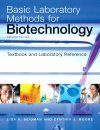About this book
Presented from the perspective of the biotech industry, this laboratory handbook/textbook reference gives a systematic, understandable, and practical introduction to fundamental laboratory methods and provides a foundation upon which students can build a career in the lab. The authors balance background and theory with practical information, drawing material from many sources: analytical chemistry texts, molecular biology manuals, industry standards, government regulations, manufacturer and supplier information, and the useful laboratory "lore" that is part of the industry's oral tradition.
The second edition features two new chapters covering Quality Assays and Tests (Chapters 24 and 25) and a new chapter on Culture Media for Intact Cells (Chapter 30). The authors have made revisions to update the safety chapters, the methods chapters, and have reorganized the units so that the information is presented in an order that mimics a typical class. They have also completely rewritten the Computers and Biotechnology chapters as well as the introductory chapter to more accurately reflect the evolving nature of the biotechnology industry. This new edition also reflects the changes in the field of biotechnology, how profit and other metrics affect research, the pursuit of new ideas, and the implementation of product testing and government approval.
Contents
I. INTRODUCTION TO THE BIOTECHNOLOGY WORK PLACE
1. The Modern Biotechnology Industry: A Broad Overview
2. The Business of Biotechnology: The Transformation of Knowledge into Products
3. Pharmaceutical/Biopharmaceutical Products
II. PRODUCT QUALITY AND BIOTECHNOLOGY
4. Introduction to Product Quality Systems
5. Biotechnology and the Regulation of Food and Medical Products
6. Documentation, the Foundation of Quality
7. Quality Systems in the Production Facility
8. Quality Systems in the Laboratory
III. SAFETY IN THE LABORATORY
9. Introduction to a Safe Workplace
10. Working Safely in the Laboratory: General Considerations and Physical Hazards
11. Working Safely with Chemicals
12. Working Safely with Biological Materials
IV. MATH IN THE BIOTECHNOLOGY LABORATORY: AN OVERVIEW
13. Basic Math Techniques
14. Proportional Relationships
15. Relationships and Graphing
16. Descriptions of Data (Descriptive Statistics)
V. LABORATORY MEASUREMENTS
17. Introduction to Quality Laboratory Measurements, Tests and Assays
18. Introduction to Instrumental Methods and Electricity
19. The Measurement of Weight
20. The Measurement of Volume
21. The Measurement of Temperature
22. The Measurement of pH, Selected Ions and Conductivity
23. Measurements Involving Light A. Basic Principles and Instrumentation
VI. QUALITY ASSAYS AND TESTS
24. Introduction to Quality Laboratory Tests and Assays
25. Measurements Involving Light B. Applications and Methods
VII. LABORATORY SOLUTIONS
26. Preparation of Laboratory Solutions A: Concentration Expressions and Calculations
27. Preparation of Laboratory Solutions B. Basic Procedures and Practical Information
28. Solutions: Associated Procedures and Information
29. Laboratory Solutions to Support the Activity of Biological Macromolecules
30. Culture Media for Intact Cells
VIII. BASIC SEPARATION METHODS
30. Introduction to Filtration
31. Introduction to Centrifugation
32. Introduction to Bioseparations
IX. COMPUTERS IN THE LABORATORY
33. Computers: An Overview
34. Data Handling with Computers
35. Applications of the Internet to Biotechnology
Customer Reviews
Biography
Lisa Seidman received her Ph.D. from the University of Wisconsin and has taught for over twelve years in the Biotechnology Laboratory Technician Program at Madison Area Technical College, Madison, Wisconsin.
Cynthia Moore received her doctoral degree from Temple University School of Medicine and has a career both in research and as a science educator. She is currently a faculty member in the Department of Biological Sciences at Illinois State University, Normal, Illinois.
























